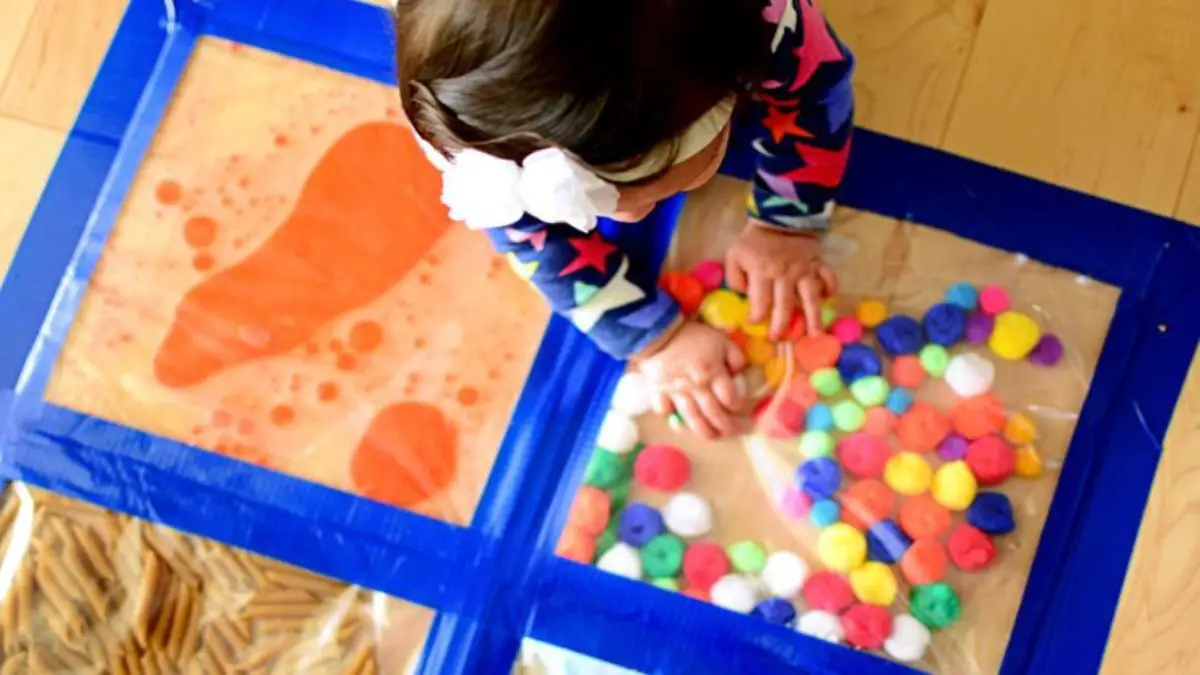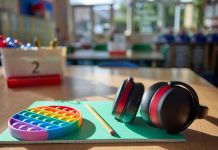With the help of sensory bags, kids learn to use their imagination and enhance their creativity while engaging multiple senses!
Sensory bags (also known as squish bags) allow children to discover and explore colors, textures, and much more.
So why is a little bag filled with water and stuffed with doo-dads so important?
Sensory play is critical for all children. After all, it supports language development, refines gross motor skills, and enhances problem-solving skills.
However, sensory play is particularly important for children struggling with sensory processing issues.
Sensory play is beneficial for children with low and even high-functioning autism, as it stimulates the brain and improves sensory processing.
Moreover, it allows autistic children to connect with others and improve their communication and motor skills.
While you can definitely find several toys and accessories like swings for sensory play on the market, one of the best toys you can create at home with minimal effort is a sensory bag.
And perhaps the best feature of sensory bags is that they are mess-free, so they are usually the top choice for moms as they do not require post-play cleanup.
One of the other features that make sensory bags so awesome is portability. You can carry them along anywhere you want, whether you are at a restaurant or are waiting in the doctor’s office.
With a sealed squish bag, your kids can easily manipulate the contents and spend time constructively.
Sensory Bags for Children with Autism
According to the CDC, 1 in 54 children in the U.S. is diagnosed with autism. Such children usually have trouble processing sensory stimulation.
As parents or guardians of autistic children, one must keep in mind that they have special needs that require you to pay more attention to their behaviors and to feel especially around people.
Given the special needs of autistic children, sensory bags are particularly helpful as they offer the following benefits:
- Sensory toys, particularly sensory bags, allow autistic children to calm down and relax in case of a particularly exciting event or scenario.
- Sensory bags allow autistic children to focus and grasp objects with less fear and discomfort. As a result, sensory bags play a key role in helping them play naturally and comfortably.
- With the help of sensory bags, kids with autism can develop their social learning skills, including negotiation, planning, and sharing.
- Playing with sensory bags encourages young children to use their hands’ small muscles, which helps develop their gross and fine motor skills.
- Playing with sensory bags also stimulates the brain and creates neurological pathways, which help autistic children improve their neural processing systems.
- Since autistic children have trouble communicating with others, playing with sensory bags can improve their social skills, vocabulary, and language skills.
- Finally, it enhances coordination and offers a lot more while giving your kids a mess-free opportunity to spend time constructively.
How to Make Sensory Bags
Now that you’ve been made aware of the numerous benefits of a DIY sensory bag for autism, it’s time to learn how to make them!
What You’ll Need
To create a good sensory bag, you will need…
- Ziploc bags (choose the size you prefer)
- Hair gel or hand sanitizer
- Food color
With these three basic things, you have the foundation for learning how to make sensory bags. With this water-base, you can go for an ocean design- just add lots of glitter, create something for sorting colors, shapes, alphabets, and a whole lot more.
Some of the materials for filling up your bag include, but are not limited to…
- Squishes
- Pom poms
- Glitter
- Plastic shapes
- Water or glass beads
- Stickers
- Buttons
- Plastic letters, shapes, or numbers
- Magnets
- Googly eyes
- Rice
- Leaves
- Flowers
- Seashells
- Foam shapes
- Feathers
- Small plastic toys with blunt edges
- Oatmeal
- Dried noodles, beans, or lentils
- Marbles
- Small rocks
- Confetti
- Mini ornaments
For a more solidified base, you can use flour and water.
For one bag, you will need 1 cup of flour, a few drops of food coloring, and six tablespoons of water.
Mix all the ingredients well, and you will get a dry, solidified base that you can use to add the materials of your choice.
What’s Next?
Once you create the base and have decided on what you want to include in your squish bag, the rest is all fun.
Give it the color you desire or add in glitter to give your sensory bag the sparkle your child loves!
And finally, add in the pom-poms, trinkets, leaves, flowers, or any other filling materials of your choice.
Lastly, make sure you seal it. Once you have all the required materials inside the Ziploc bag, you must squeeze out all the extra air from the bag.
The trick is to make sure that the gel can still freely move around in the bag. Then, zip the bag and tape the outer sides of the Ziploc bag using duct tape.
It’s best to use duct tape on the sides of the Ziploc bag so the contents of your bag remain safe when your child plays with it.
Over to You!
Sensory play is essential for all kids, but it is particularly beneficial for autistic children as they have trouble processing sensory information.
And one of the best sensory toys you can easily create is a sensory bag. Using the materials of your choice, you can create a sensory bag that your autistic child would love to play with and use to decompress in any setting.
With the materials mentioned above and everything else around you, you can get creative with your sensory bag and give your child the love and attention they need to survive and thrive.
We hope that this post helped answer any questions regarding how to make a good DIY sensory bag!
Until next time, readers!







